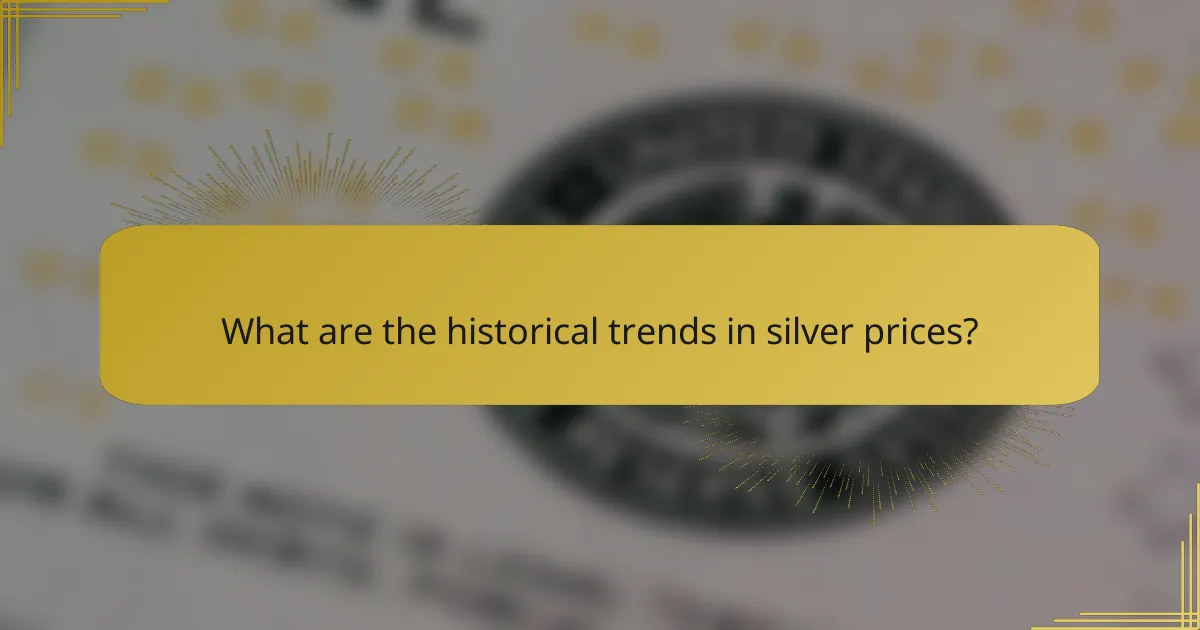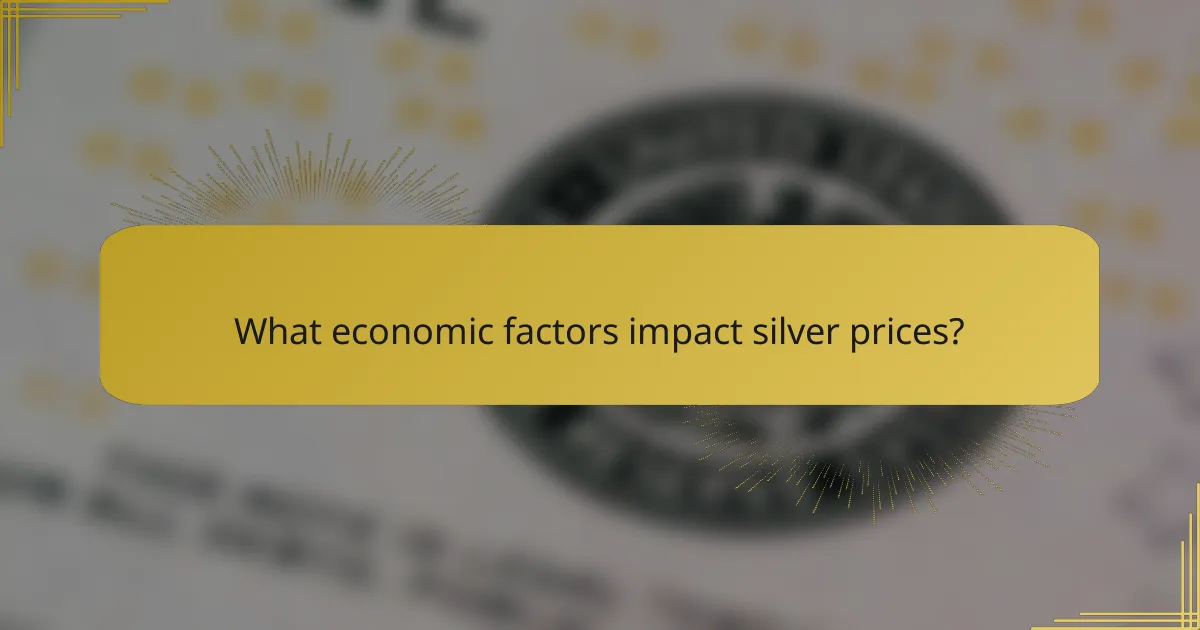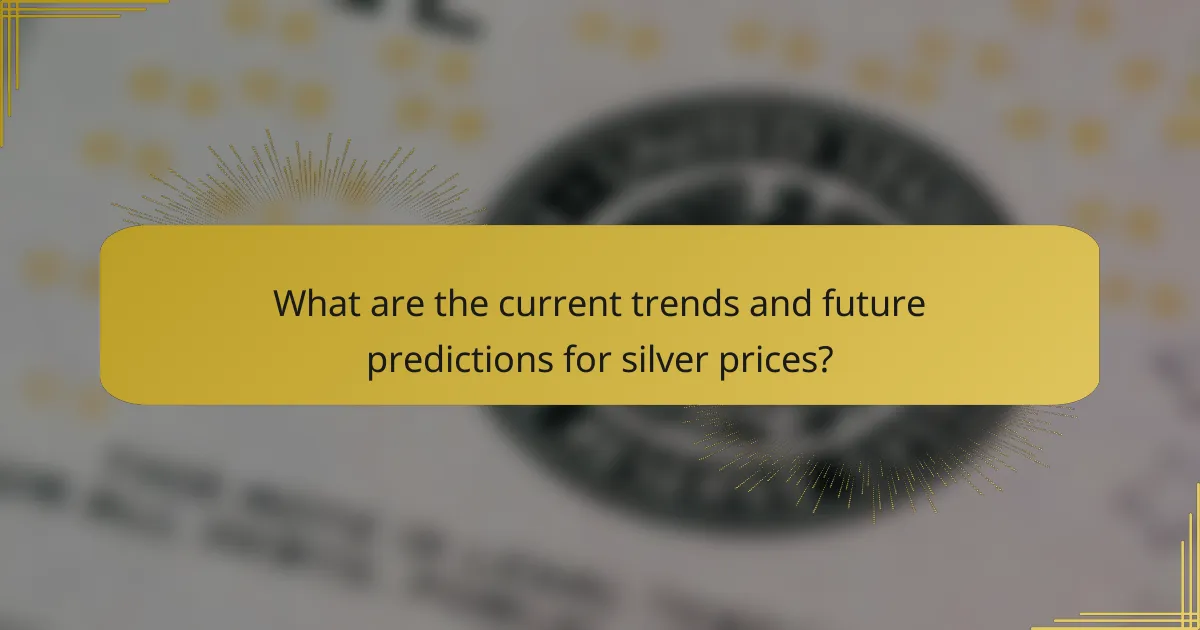Silver prices have undergone significant fluctuations throughout history, influenced by various economic factors and market dynamics. From a dramatic rise between 1970 and 1980, where prices surged from approximately $1.50 to nearly $50 per ounce, to a stabilization in the 1990s, silver has consistently reflected changes in industrial demand, economic uncertainty, and geopolitical events. Key factors impacting silver prices include supply and demand dynamics, inflation rates, and the strength of the US dollar. As of late 2023, silver prices have reached around $25 per ounce, driven by increased industrial demand, particularly in electronics and renewable energy, alongside ongoing inflation concerns. Future predictions indicate a potential rise to $30 per ounce by 2025, supported by supply constraints and growing global demand.

What are the historical trends in silver prices?
Silver prices have experienced significant fluctuations throughout history. From 1970 to 1980, prices surged from around $1.50 to nearly $50 per ounce. This spike was primarily driven by speculative trading and industrial demand. In the 1990s, silver prices stabilized between $4 and $7 per ounce. The early 2000s saw a gradual rise, reaching about $20 per ounce by 2011.
During this period, factors such as economic uncertainty and increased investment in precious metals influenced prices. The price peaked again in 2011 due to a combination of market speculation and global economic concerns. Since then, silver prices have fluctuated, with notable dips and recoveries, reflecting shifts in market demand, economic conditions, and geopolitical events. Historical data shows that silver prices are often correlated with gold prices, as both are considered safe-haven assets.
How have silver prices changed over the decades?
Silver prices have fluctuated significantly over the decades. In the 1970s, silver prices surged from around $1.50 per ounce to nearly $50 per ounce, driven by inflation and investment demand. The 1980s saw a sharp decline, with prices dropping to approximately $5 per ounce by the end of the decade. In the 1990s, silver prices stabilized, averaging around $4 to $6 per ounce.
The early 2000s marked a resurgence, with prices rising steadily due to increased industrial demand and investment interest. By 2011, silver reached a peak of about $48 per ounce. Following this, prices experienced volatility, dropping to around $14 per ounce in 2015. Since then, silver has generally trended upward, reflecting both economic conditions and investor sentiment. As of 2023, silver prices are approximately $25 per ounce, demonstrating a recovery and ongoing demand in various sectors.
What major events influenced silver price fluctuations?
Major events influencing silver price fluctuations include economic crises, changes in industrial demand, and geopolitical tensions. The 2008 financial crisis led to increased investment in silver as a safe haven, driving prices up. In contrast, the COVID-19 pandemic initially caused a drop in silver prices due to reduced industrial demand. The rise of electric vehicles has increased silver’s industrial demand, affecting its price positively. Geopolitical tensions, such as trade wars and conflicts, often lead to price spikes as investors seek stability. Historical data shows that these events correlate with significant price shifts in the silver market.
How do inflation rates correlate with historical silver prices?
Inflation rates generally have a positive correlation with historical silver prices. As inflation rises, the purchasing power of currency declines. Investors often turn to silver as a hedge against inflation. For example, during the 1970s, high inflation rates coincided with a significant increase in silver prices, peaking in 1980. Historical data shows that periods of elevated inflation often lead to increased demand for precious metals like silver. This trend is supported by the inverse relationship between the U.S. dollar’s value and silver prices during inflationary periods. Additionally, the Consumer Price Index (CPI) data indicates that as inflation rates increased, silver prices also tend to rise, reinforcing this correlation.
What patterns can be observed in silver price movements?
Silver price movements often exhibit cyclical patterns influenced by various economic factors. Historically, silver prices tend to rise during economic uncertainty or inflationary periods. For example, during the 2008 financial crisis, silver prices surged as investors sought safe-haven assets. Additionally, silver often follows gold price trends due to their correlation as precious metals. Seasonal patterns can also be observed, with prices typically increasing in the first quarter of the year. Supply and demand dynamics significantly impact prices; for instance, industrial demand can drive prices higher during technological booms. Market sentiment, driven by geopolitical events, can lead to sudden price fluctuations. Overall, these patterns reveal the complex interplay between economic conditions and silver price movements.
What seasonal trends are evident in silver pricing?
Silver pricing exhibits seasonal trends influenced by various factors. Typically, prices tend to rise during the first quarter of the year. This increase is often attributed to heightened demand for silver in jewelry and industrial applications. The festive season, particularly in countries like India, drives up demand around this time.
In the second quarter, silver prices may stabilize or decline. This is due to reduced buying after the festive season. However, prices can rebound in the third quarter, coinciding with increased industrial activity. The electronics and solar industries often ramp up production during this period, boosting silver demand.
The fourth quarter usually sees a mix of trends. Prices can fluctuate based on market speculation and investment trends. Historical data shows that silver prices often peak in late winter or early spring. According to the World Silver Survey, silver prices have shown consistent patterns, reflecting these seasonal influences over the years.
How do silver prices compare to other precious metals historically?
Silver prices have historically been lower than gold prices but higher than those of platinum and palladium. For instance, in the early 2000s, silver traded around $5 per ounce, while gold was priced over $300 per ounce. This trend continued until 2011 when silver peaked at approximately $49.50 per ounce, while gold reached around $1,900 per ounce. Over the past decades, the gold-to-silver ratio has averaged around 60:1, meaning it takes about 60 ounces of silver to equal the price of one ounce of gold. In contrast, platinum has often traded at a premium to silver, particularly in the early 2000s, but has seen fluctuations. Historical data indicates that silver tends to follow gold’s trends but with more volatility.

What economic factors impact silver prices?
Economic factors that impact silver prices include supply and demand dynamics, inflation rates, and currency strength. Supply and demand influence prices directly; when demand exceeds supply, prices rise. Inflation rates affect silver as a hedge; higher inflation often leads to increased investment in silver. Currency strength, particularly the US dollar, inversely affects silver prices; a weaker dollar typically boosts silver prices. Additionally, industrial demand, particularly from electronics and solar energy, plays a significant role. For instance, in 2020, global silver demand was approximately 1.03 billion ounces, with a notable increase in industrial use.
How do supply and demand dynamics affect silver pricing?
Supply and demand dynamics significantly impact silver pricing. When demand for silver increases, prices tend to rise. This demand can stem from various sectors, including electronics, jewelry, and investment. Conversely, if supply outpaces demand, prices typically decline. For example, in 2020, increased investment demand during economic uncertainty led to higher silver prices, reaching nearly $30 per ounce. Supply factors include mining output and recycling rates. A decrease in mining production can tighten supply, pushing prices upward. Historical data shows that fluctuations in these dynamics directly correlate with price changes in the silver market.
What role do mining outputs play in silver price determination?
Mining outputs significantly influence silver price determination. Increased silver mining outputs generally lead to lower prices due to higher supply. Conversely, reduced mining outputs can cause prices to rise as supply diminishes. For instance, in 2020, global silver mine production fell by 8% due to pandemic-related disruptions. This decline contributed to a price increase, illustrating the direct correlation between mining outputs and market prices. Additionally, mining outputs affect investor sentiment and market speculation, further impacting silver prices.
How does industrial demand influence silver prices?
Industrial demand significantly influences silver prices. As industries such as electronics, solar energy, and automotive utilize silver, increased demand drives prices upward. For instance, the International Energy Agency reported that solar panel production accounted for about 10% of silver demand in 2021. When industrial sectors expand, they require more silver for manufacturing processes. This heightened demand can lead to supply shortages, further elevating prices. Conversely, if industrial demand decreases, prices may decline due to excess supply. Historical data shows that fluctuations in industrial demand have consistently correlated with shifts in silver prices.
What is the relationship between silver prices and the global economy?
Silver prices are closely tied to the global economy. Economic growth typically increases demand for silver in industries like electronics and solar energy. Conversely, during economic downturns, silver prices often decline due to reduced industrial demand. Additionally, silver is viewed as a safe-haven asset. Investors may turn to silver during times of economic uncertainty, driving up its price. Historical data shows that silver prices often rise in response to inflation and currency devaluation. For instance, during the 2008 financial crisis, silver prices surged as investors sought refuge from volatile markets. Thus, the relationship between silver prices and the global economy is characterized by demand fluctuations and investor behavior in response to economic conditions.
How do economic recessions impact silver prices?
Economic recessions typically lead to an increase in silver prices. During recessions, investors often seek safe-haven assets, and silver is considered one of them. This increased demand can drive up prices. Historical data shows that during the 2008 financial crisis, silver prices rose significantly as investors moved away from riskier assets. In contrast, economic recovery phases often see a decrease in silver prices as risk appetite increases. Thus, silver prices are inversely correlated with economic growth indicators.
What is the correlation between silver prices and currency strength?
Silver prices generally have an inverse correlation with currency strength. When a currency weakens, investors often turn to silver as a safe-haven asset. This increase in demand typically drives silver prices higher. Conversely, when a currency strengthens, silver prices may decline due to reduced demand. Historical data shows that during periods of economic uncertainty, such as the 2008 financial crisis, silver prices rose significantly as the US dollar weakened. Additionally, fluctuations in the US dollar index often correlate with changes in silver prices, reinforcing this inverse relationship.

What are the current trends and future predictions for silver prices?
Current trends in silver prices show a significant increase, with prices reaching around $25 per ounce in late 2023. This rise is attributed to heightened industrial demand, particularly in electronics and renewable energy sectors. Additionally, inflation concerns and geopolitical tensions have driven investors towards silver as a safe haven. Future predictions suggest that silver prices may continue to rise, potentially reaching $30 per ounce by 2025. Analysts cite ongoing supply constraints and increasing global demand as key factors supporting this forecast. Historical data indicates that silver often performs well during economic uncertainty, reinforcing the likelihood of price increases in the coming years.
How do analysts forecast future silver price movements?
Analysts forecast future silver price movements using various methods. They analyze historical price trends to identify patterns. Technical analysis involves charting past prices to predict future movements. Fundamental analysis examines supply and demand factors affecting silver. Economic indicators, such as inflation and interest rates, also influence forecasts. Analysts may consider geopolitical events that impact market stability. Additionally, they utilize sentiment analysis to gauge investor behavior. Data from market reports and mining production statistics serve as critical inputs for their predictions.
What indicators are used to predict silver price trends?
Indicators used to predict silver price trends include supply and demand dynamics, economic data, and market sentiment. Supply and demand significantly influence silver prices. For instance, an increase in industrial demand can drive prices higher. Economic indicators such as inflation rates and interest rates also impact silver prices. Higher inflation typically leads to increased silver investment as a hedge. Market sentiment, reflected in investor behavior and trading volumes, can indicate potential price movements. Technical analysis using charts and historical price patterns further aids in predicting trends. These indicators collectively help investors make informed decisions regarding silver investments.
How do geopolitical events influence future silver pricing?
Geopolitical events significantly influence future silver pricing. These events create uncertainty in global markets. For instance, conflicts can disrupt supply chains. This disruption often leads to increased demand for silver as a safe-haven asset. Historical data shows that during times of geopolitical tension, silver prices tend to rise. In 2008, for example, silver prices surged amid the financial crisis. Additionally, trade wars can impact silver production and export rates. This can lead to fluctuations in pricing based on perceived risks. Overall, geopolitical factors create volatility that directly affects silver market dynamics.
What investment strategies can be applied to silver?
Investment strategies for silver include physical ownership, ETFs, and futures contracts. Physical ownership involves buying silver bullion or coins. This strategy provides tangible assets that can serve as a hedge against inflation. Exchange-Traded Funds (ETFs) allow investors to buy shares that track silver prices without holding the metal directly. This method offers liquidity and ease of trading. Futures contracts enable investors to speculate on future silver prices. This strategy can amplify profits but also increases risk. Dollar-cost averaging is another approach, where investors buy silver at regular intervals. This strategy reduces the impact of price volatility. Finally, diversification with silver in a broader portfolio can mitigate risks associated with market fluctuations. Each strategy has its own risk and reward profile, making it essential for investors to assess their financial goals.
How can investors capitalize on silver price trends?
Investors can capitalize on silver price trends by using various strategies. They can buy silver when prices are low and sell when prices rise. This approach requires monitoring market trends and historical price data. Investors may also consider diversifying their portfolios with silver ETFs or mining stocks. Silver historically acts as a hedge against inflation. In 2020, for example, silver prices surged by over 47% amid economic uncertainty. Keeping an eye on global economic indicators can also provide insights into potential price movements. Understanding supply and demand dynamics is crucial for making informed decisions.
What are the risks associated with investing in silver?
Investing in silver carries several risks. Price volatility is a primary concern, as silver prices can fluctuate significantly due to market demand and economic conditions. This volatility can lead to substantial financial losses for investors.
Liquidity risk is another factor. In times of economic uncertainty, selling silver may become challenging, potentially resulting in lower prices. Additionally, silver is subject to market manipulation, which can distort prices and impact investor returns.
Storage and security risks also exist. Physical silver must be stored securely, which can incur additional costs. Furthermore, theft or loss of physical assets can lead to financial losses.
Lastly, regulatory risks can affect the silver market. Changes in laws or regulations may impact silver trading and investment strategies. These factors collectively highlight the complexities and risks associated with investing in silver.
What practical tips should investors consider when analyzing silver prices?
Investors analyzing silver prices should consider market demand and supply dynamics. Silver prices are influenced by industrial demand, especially in electronics and solar panels. Monitoring global economic indicators can provide insights into potential price movements. Investors should also track the performance of the U.S. dollar, as silver often moves inversely to it. Historical price trends reveal patterns that may indicate future movements. Additionally, geopolitical events can impact silver prices, making it essential to stay informed on global news. Analyzing silver’s correlation with gold can also provide valuable context for price expectations. Finally, utilizing technical analysis tools can help identify entry and exit points for investment.
The main entity of this article is silver prices, which have shown significant historical fluctuations influenced by various economic factors. The article provides an overview of historical trends in silver prices from the 1970s to 2023, highlighting key events that have impacted pricing, such as economic crises, industrial demand, and geopolitical tensions. It examines the correlation between silver prices and inflation rates, supply and demand dynamics, and the relationship between silver prices and other precious metals. Additionally, the article discusses current trends, future predictions, and investment strategies, along with practical tips for analyzing silver prices effectively.